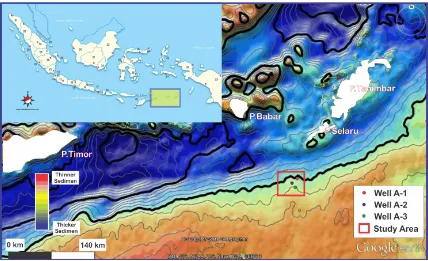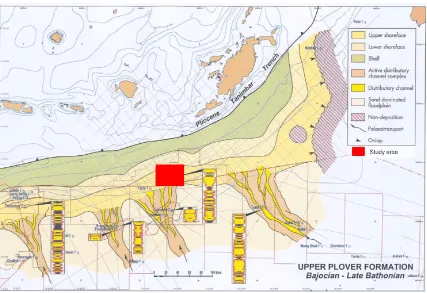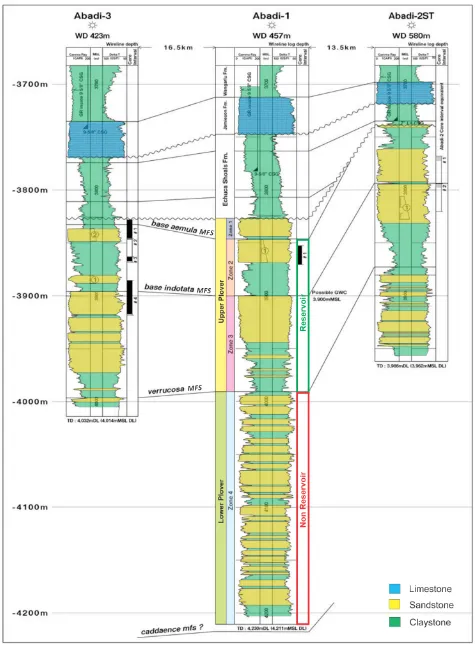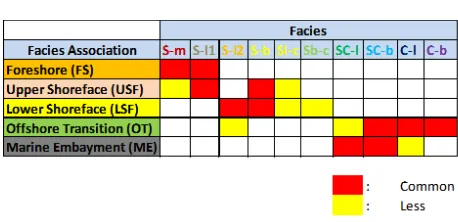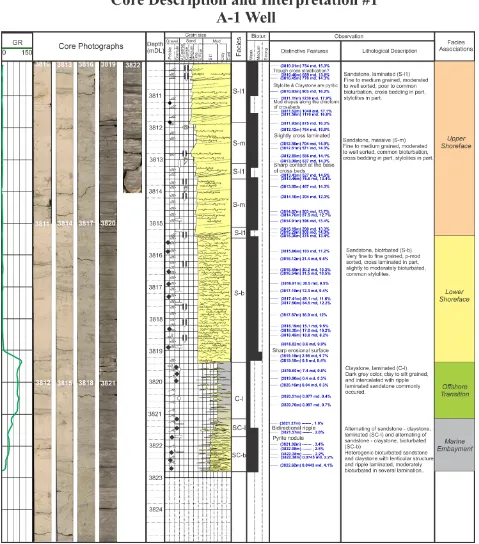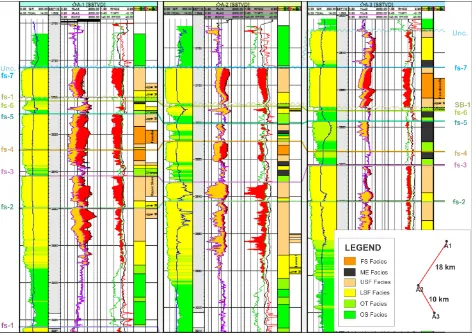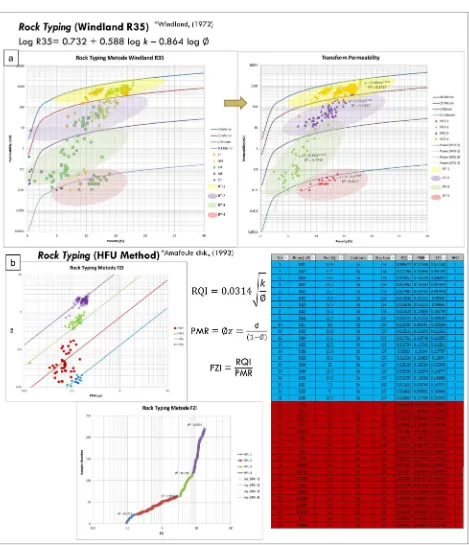Journal of Applied Geology, vol. 1(1), 2016, pp. 43–52
Petrophysics Analysis for Reservoir Characterization of Upper Plover
Formation in the Field “A”, Bonaparte Basin, Offshore Timor, Maluku,
Indonesia
Sugeng Sapto Surjono∗and Indra Arifianto
Department of Geological Engineering, Gadjah Mada University, Yogyakarta, Indonesia
ABSTRACT. Hydrocarbon potential within Upper Plover Formation in the Field “A” has
not been produced due to unclear in understanding of reservoir problem. This formation consists of heterogeneous reservoir rock with their own physical characteristics. Reservoir characterization has been done by applying rock typing (RT) method utilizing wireline logs data to obtain reservoir properties including clay volume, porosity, water saturation, and permeability. Rock types are classified on the basis of porosity and permeability distri-bution from routines core analysis (RCAL) data. Meanwhile, conventional core data is uti-lized to depositional environment interpretations. This study also applied neural network methods to rock types analyze for intervals reservoir without core data. The Upper Plover Formation in the study area indicates potential reservoir distributes into 7 parasequences. Their were deposited during transgressive systems in coastal environments (foreshore -offshore) with coarsening upward pattern during Middle to Late Jurassic. The porosity of reservoir ranges from 1–19 % and permeability varies from 0.01 mD to 1300 mD. Based on the facies association and its physical properties from rock typing analysis, the reservoir within Upper Plover Formation can be grouped into 4 reservoir class: Class A (Excellent), Class B (Good), Class C (Poor), and Class D (Very Poor). For further analysis, only class A-C are considered as potential reservoir, and the remain is neglected.
Keywords: Upper Plover Formation·Rock typing·Depositional environment·Bonaparte basin·Maluku·Indonesia.
1 INTRODUCTION
Plover Formation is the main target for hydro-carbon production in North West Offshore Aus-tralia as well as the Outer Banda arc of Indone-sia (Barberet al., 2003). However, in the Field “A” the upper part of this formation has not been produced and need to further study to re-veal the characteristics and hydrocarbon poten-tial within reservoir. Geographically, the study area took place in the offshore Maluku, about 70 km to the south of the Selaru Island, Maluku Provinces (Figure 1) and geologically belong to the Bonaparte Basin.
The Upper Plover Formation was deposited
∗Corresponding author: S.S. SURJONO, Depart-ment of Geological Engineering, Gadjah Mada Univer-sity. Jl. Grafika 2 Yogyakarta, Indonesia. E-mail: sugengssurjono@ugm.ac.id
during transgression phase within transitional to shallow marine environments, which pro-duce heterogeneous succession of sedimentary rocks. Understanding of depositional environ-ment and petrophysics leads the grouping of rocks types, which then useful to support mod-eling process and calculation of hydrocarbon in place. The study was carried out to identify ver-tically facies succession of each sequence, to de-termine physical properties and fluid content of reservoir, and to classify rock types of reservoir within interest zone.
Figure 1: Research area located in the southern outer Banda Arc, of Offshore Maluku, where three exploratory wells are available as primary data in this study.
are otillized to run reservoir characterization using IP (Interactive Petrophysics) software.
2 REVIEW OFPLOVERFORMATION
Research area is considered as northern part of the passive Australian plate boundaries and lies on Calder Graben, Bonaparte Basin. Calder Graben has southeast rifting pattern that formed northeast - southwest trending structures. This Graben has thick succession of Jurrasic – Cretaceous sediments that according to Barberet al.(2003), the early Jurassic massive erosion truncate the Abadi High Pre-Cambrian to the Triassic interval. Continental to shelfal marine sedimentation continued throughout Early to Middle Jurassic, leading to deposition of the Malita Formation red beds and overlying Plover Formation fluvio-deltaic sediments up to 1500–2000 m thick, and terminated by rifting (break-up) on the Australian continental crust during the Oxfordian.
According to Helby et al. (1987), the charac-teristics of lithology in conjunction with bios-tratigraphic control indicate that sedimentation patterns during Plover Formation times were dominated by a series of widespread braided trunk river systems feeding a relatively narrow wave-dominated coastline and beyond a wide
marine shelf. The river system has relatively northwest – southeast directions along a line of weakness provided by the axis of the Goulburn Graben. Study area is most probably situated in the shoreface area where rivermouths dis-tributed sediments northward to the shelf (Fig-ure 2).
predomi-PETROPHYSICSANALYSIS FORRESERVOIRCHARACTERIZATION OFUPPERPLOVERFORMATION
Figure 2: Paleogeography of Upper Plover Formation indicate fluvial to shelfal depositional envi-ronments during Middle Jurassic (Barberet al., 2003).
nantly medium grained sands. In the well logs, it is characterized by a blocky log profile and excellent reservoir properties. The Zone 1 is the top of Plover Formation, which then overlain by Echuca Shoals and marked by regional un-conformity. It comprises a thin succession of non-reservoir quality sands possibly represent-ing deposits of an offshore. This interval only develop in Abadi-1 well and mostly are absent in other area due to erosion.
Based on the crossplot porosity versus per-meability core plug data (Nagura et al., 2003), Plover sandstone indicates three different litho-fasies. Lithofacies 1 shows high porosity and permeability values, consist of medium to coarse-grained quartzarenite with excellent visible porosity resulted by tidal delta sedimen-tation. Lithofacies 2 is characterized by fine to medium grained, moderately to well sorted quartzarenite to subarkose/ sublitharenite. Al-though the magnitude of lithofacies 2 is lower than Facies 1, but it still retains good reser-voir properties. Lithofacies 3 is predominantly medium-grained, moderately to well sorted, clean quartzarenite. It is below the gas water
contact and characterized by diagenetic calcite cement dominant.
3 RESEARCH METHODS
To run the reservoir characterization using IP software, well data including wireline log and core are used as input data. Qualitative analy-sis to interpret lithofacies and depositional en-vironment as well as quantitative analysis to petropysics calculation have been done in this study. Before all analyses were carried out, the first step is to do well quality control data. As horizons marker for interval are given in each well, stratigraphic correlations among wells are sequentially carried out to determine reservoir zone intervals and to ensure that they are ap-propriate for further analysis. The next step is determining the facies and depositional envi-ronment of each stratigraphic sequence in each well with lithology data (core) and wireline logs data using electrofacies method then followed by quantitative analysis.
PETROPHYSICSANALYSIS FORRESERVOIRCHARACTERIZATION OFUPPERPLOVERFORMATION
rock properties such as clay volume, poros-ity and water saturation (Tiab and Donaldson, 1996). Rock typing (RT) carried out to clas-sify the rock type of routine core analysis data (RCAL), followed by distributing rock type us-ing neural network for rock intervals that do not supported by core data. Result of those an-alyzes will be used to identify the character of the reservoir. Rock type form whole well log is predicted by neural network method. This method has been proven to successfully applied as a predictive tool lithofasies by Bohling and Dubois (2003).
In this study, reservoir rock typing in the “A” Field is carried out by “Windland R35” meth-ods by Windland (1972) Equation 1 and using Hydraulic Flow Unit (HFU) by Amaefuleet al.
(1993) Equations 2-4. The concept of these two methods is to identify and characterize rock types based on geological conditions and phys-ical parameters of the pore size (Radiansyah, 2014).
4 RESULTS ANDDISCUSSION
Facies and depositional environment
Core description (Figure 4) provides typical sedimentary succession of Upper Plover For-mation for Zone-2. It consists of sandstone and claystone lithofacies with coarsening up-ward succession. In the lower part, biotur-bated sandstone-claystone (SC-b), laminated sandstone-claystone (SC-l) and laminated clay-stone (C-l) vertically develop with total thick-ness around 4.5 m. to the upper part, lithofacies changes to sandstone dominant including bio-turbated sandstone (Sb), and interbedding of laminated sandstone (S-l1) and massive sand-stone (S-m) to form thickly bedded succession up to around 10 m. In the Well A-2 lithofacies S-l1 and S-b identified in more cemented become
Table 1: Facies association of progradation shoreline depositional environment
lithofaceis cemented laminated sandstone (Sl-c) and cemented bioturbated sandstone (Sb-c).
Lithofacies assemblage with associated in sedimentary attributes lead to depositional en-vironment interpretation (Miall, 1990) is termed as facies association. In the study area, six fa-cies association interpreted based on the core description and interpretation, which then cor-relate to well logs analysis. Facies association represents depositional environment and com-posing lithofacies served in Tabel 1, which are: (1) foreshore (FS), (2) upper shoreface (USF), (3) lower shoreface (LSF), (4) offshore transi-tion (OT), (5) marine embayment (ME) and (6) offshore (OS). General succession for Upper Plover is coarsening upward, where depo-sitional environment relatively change from marine to transitional zone of shoreface or even estuarine (Figure 2–4 .
Stratigraphy
PETROPHYSICSANALYSIS FORRESERVOIRCHARACTERIZATION OFUPPERPLOVERFORMATION
Plover as unconformity boundary at Late Juras-sic age (Figure 5).
Six parasequence is defined from flooding surface boundary (Van Wagoner et al., 1988) indicates vertically regressive with thinner parasequence. Laterally, to the northward, de-positional environment tends to deeper due to increasing sand-shale ratio (Figure 2).
Rock type identification
Two methods have been applied to identify rock types (RT) that are Windland R-35 (Wind-land, 1972) and Hydraulic Flow Unit (Amae-fule et al., 2003), in order to get the best re-sult. RT identification by Windland R-35 is car-ried out by plotting all value of porosity ver-sus permeability from RCAL to define iso pore throat curve. In this study, four different iso pore throat curve was identified, which are 0.1 micron, 2 micron, 15 micron and 40 micron (Fig-ure 6a left side). Iso pore throat curve represent one rock type (RT) that consist of certain facies association, therefore four RT are also defined from this methods.
Hydraulic Flow Unit (HFU) methods for grouping characters rock types has a similar way to the “Windland R-35” methods. RT by HFU method is identified by value of Flow Zone Indicator (FZI) or cross plot Reservoir Quality Index value (RQI) versus Matrix Pore Ratio (PMR) or φz (Figure 6b). From FZI cal-culation and crossplot log RQI versus φz, the Upper Plover Formation is can be divided into four HFU.
Final RT identification is taken from the highest number of coefficient correlation (R) of transform permeability. Four RT is identified from this final result (Figure 6a, right side).
Reservoir characterization
The reservoir quality classification refers to the classification of reservoir established by Slatt and Hopkins, 1991 (in Slatt, 2006). Parame-ter used to distinguish reservoir classification is permeability, porosity, matrix grain size, pore throat, minimum water saturation and litho-fasies . Based on those parameter, Upper Plover Formation can be divided into four classes of reservoir, that are:
A Class dominantly consists of the FS and USF facies association, has the most
ex-cellent quality reservoir porosity that is 6.5–19 % with permeability ranging from 100–1300 mD.
B Class dominantly consists of USF, FS and LSF facies association, have good quality reservoir with porosity of 7–17 % and per-meability of 10 to 200 mD.
C Class dominantly consists of LSF dominant facies association, ME and OT facies asso-ciation, have poor reservoir quality with a porosity of 1-13 % and permeability of about 0.1–2 mD.
D Class consists of LSF, USF and OT facies as-sociation, with experiencing diagenetic ce-mentation, porosity 1–14 % with perme-ability 0.001–0.08 mD. This class is consid-ered not a reservoir type due to unable to flow the reservoir fluid.
5 CONCLUSIONS
The Upper Plover Formation in the study area consist of alternating sandstones and shales to form coarsening upward sedimentary succes-sion deposited mainly within marine to coastal environment of foreshore – offshore. The suc-cession can be divided into 7 parasequences, ranges from Middle to Late Jurassic age.
The reservoir of Upper Plover Formation can divided into four classes: A class has excellent quality, B class with good quality, C class with poor quality and D class with very poor quality.
ACKNOWLEDGEMENTS
Authors would like to express the deepest thanks to Directorate General Oil and Gas of Republic Indonesia for permission in using sub surface data within the study area. Thanks also to member of G and G Study team for fruitful discussion during preparing the manuscript.
REFERENCES
Amaefule, J., Altunbay, M., Tiab, D., Kersey, D., and Keelan, D. (1993) Enhanced Reservoir Description Using Core and Log Data to Identify Hydraulic Flow Units and Predict Permeability in Uncored Intervals/Wells: SPE, 26436, p. 205–220.
Anonim (2014) Regional Geology of the Bonaparte Basin, Deptartement of Industry, Geoscience Aus-tralia, Australia.
Figure 5: Sequence stratigraphy correlation from well logs in study area.
PETROPHYSICSANALYSIS FORRESERVOIRCHARACTERIZATION OFUPPERPLOVERFORMATION
in The Timor and Arafura Seas, Eastern Indone-sia, Proceedings Indonesia Petroeleum Associa-tion 29th, Jakarta, Indonesia. IPA03-G-169 Bohling G.C., dan Dubois M.K. (2003) An
In-tegrated Application of Neural Network and Markov Chain Techniques to Prediction of Litho-facies from Well Logs, Kansas Geological Sur-vey Open File Report 2003-50, Kansas, USA, http://www.kgs.ku.edu/PRS/publication/2003/ofr-2003-50.pdf (13 April 2015)
Elliot, T. (1986) Siliciclastic Shorelines, in Reading, H.G., ed., Sedimentary Environments and Facies 2ndEd. Blackwell Scientific Publication, Oxford, UK. p. 155-188
Gunter, G., Finneran, J., Hartmann, D. and Miller, J. (1997) Early Determination of Reservoir Flow Units Using an Integrated Petrophysical Method: SPE 38679, 8 p.
Helby, R., Partridge, A.D., 2001. Bonbonadinium granulatum gen. et sp. nov., a Late Jurassic (Tithonian) dinoflagellate cyst from the North-West Shelf, Australia. Memoir of the Association of Australasian Palaeontologists 24, p. 221-224. Matsui, R., Shinbo, E., Omokawa M., Zushi T. (2009)
Quartz Cementation and Reservoir Quality of the Plover Sandstone in the Abadi Gas Field. Pro-ceedings Indonesia Petroeleum Association 33th, Jakarta, Indonesia. IPA09-G-157
Miall, A.D. (1990) Principles of sedimentary basin analysis, 2nd Ed., Springer-Verlag, New York, 668p
Nagura, H., Suzuki I., Teramoto T., Hayashi, Y., Yoshida, T., Bandjarnahor, H. MP., Kihara, K.,
Swiecicki, T., Bird, R. (2003) The Abadi Gas Field, Proceedings Indonesia Petroeleum Association 29th, Jakarta, Indonesia. IPA03-G-141
O’brien, G.W., Etheridge, M.A., Willcox, J.B., Morse, M., Symonds, P., Norman, C. And Needham, D.J. (1993) The Structural Architecture of the Timor Sea, North-Western Australia: Implications for Basin Development and Hydrocarbon Explo-ration. The APEA Journal, 33(1). p. 258–278 Radiansyah J., Putra T.E., Ismail R., Wibowo R.A.,
Riza E.E., Kurniawan M. (2014) Reservoir De-scription using Hydraulic Flow Unit and Petro-physical Rock Type of PMT Carbonate Early Miocene of Baturaja Formation, South Sumatra Basin, Extended abstract presented in AAPG In-ternational Conference & Exhibition, Istanbul, Turkey, Sept 2014.
Slatt, R.M. (2006) Stratigraphic Reservoir Character-ization For Petroleum Geologists, Geophysicists, And Engineers, Elsevier, Oxford, UK, 478 p. Tiap, D and Donaldson, C. (1996) Petrophysics:
the-ory and practice of measuring reservoir rock and fluid transport properties, Gulf Publishing Co, Houston. 705 p.
Van Wagoner, J.C., Posamentier, H.W., Mitchum, R.M., Vail, P.R., Sarg, J.F., Loutit, T.S., and Hard-enbol, J. (1988) Ann overview of the fundamen-tals of sequence stratigraphy and key definitions, SEPM Spec. Pub., No. 42, pp 39-46.
